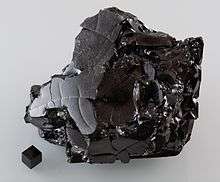Carbon chauvinism
Carbon chauvinism is a neologism meant to disparage the assumption that the chemical processes of hypothetical extraterrestrial life must be constructed primarily from carbon (organic compounds) because carbon's chemical and thermodynamic properties render it far superior to all other elements.[1]

Concept
The term was used as early as 1973, when scientist Carl Sagan described it and other human chauvinisms that limit imagination of possible extraterrestrial life. It suggests that human beings, as carbon-based life forms who have never encountered any life that has evolved outside the Earth’s environment, may find it difficult to envision radically different biochemistries.[2]
In a 1999 Reason magazine article discussing the theory of a fine-tuned universe, Kenneth Silber quotes astrophysicist Victor J. Stenger using the term:[3]
There is no good reason, says Stenger, to "assume that there's only one kind of life possible" – we know far too little about life in our own universe, let alone "other" universes, to reach such a conclusion. Stenger denounces as "carbon chauvinism" the assumption that life requires carbon; other chemical elements, such as silicon, can also form molecules of considerable complexity. Indeed, Stenger ventures, it is "molecular chauvinism" to assume that molecules are required at all; in a universe with different properties, atomic nuclei or other structures might assemble in totally unfamiliar ways.
— Victor J. Stenger, Reason, July 1999
Carbon alternatives
Like carbon, silicon can form four stable bonds with itself and other elements, and long chemical chains known as silane polymers, which are very similar to the hydrocarbons essential to life on Earth. Silicon is more reactive than carbon, which could make it optimal for extremely cold environments.[4] However, silanes spontaneously burn in the presence of oxygen at relatively low temperatures, so an oxygen atmosphere may be deadly to silicon-based life. On the other hand, it is worth considering that alkanes are as a rule quite flammable, but carbon-based life on Earth does not store energy directly as alkanes, but as sugars, lipids, alcohols, and other hydrocarbon compounds with very different properties. Water as a solvent would also react with silanes, but again, this only matters if for some reason silanes are used or mass-produced by such organisms.
Hydrocarbons and organic compounds are abundant in meteorites, comets, and interstellar clouds, while their silicon analogs have never been observed in nature. Silicon does, however, form complex one-, two- and three-dimensional polymers in which oxygen atoms form bridges between silicon atoms. These are termed silicates. They are both stable and abundant under terrestrial conditions, and have been proposed as a basis for a pre-organic form of evolution on Earth (see clay hypothesis).
See also
References
- Darling, David. "Carbon-based life". Encyclopedia of Life. Retrieved 14 September 2007.
- Sagan, Carl (1973). The Cosmic Connection. Anchor Books (Anchor Press / Doubleday). p. 47.
- Silber, Kenneth (July 1999). "Is God in the Details?". Reason Magazine. Retrieved 14 September 2007.
- "Target: Titan & Silicon-based life". Astrowright. 18 March 2010. Retrieved 5 March 2011.